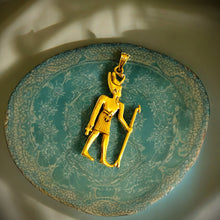
The Gold God Amun Egyptian Pendant Necklace features a design inspired by Amun, the ancient Egyptian god of creation and the sun. Amun, revered as the "King of the Gods," played a central role in Egyptian mythology, particularly during the New Kingdom period (1550–1070 BCE). This pendant, crafted with intricate detail, symbolizes power, protection, and divine authority, making it a timeless piece that connects modern wearers with ancient spiritual heritage.
- History: Inspired by ancient Egyptian art and culture, dating back thousands of years.
- Spirituality: Represents the deity Amun, associated with creation and hidden power.
- Talisman: Believed to bring protection, prosperity, and spiritual strength.
- Handmade: Crafted with care, emphasizing authenticity and artisanal quality.
- Healing: Thought to promote inner harmony and positive energy flow.
- Material: Made from gold and brass, combining durability with symbolic richness.
- Symbolism: Depicts Amun, symbolizing kingship, fertility, and divine authority.
- Wearing: Fits well on chains up to 5mm, suitable for daily wear or special occasions.
History Side For Those Who Are Interested
Amun, one of ancient Egypt's most significant deities, emerged during the Old Kingdom period (circa 2686–2181 BCE) and evolved into a prominent figure throughout Egyptian history. Initially associated with the air and wind, Amun's importance grew notably during the Middle Kingdom (circa 2055–1650 BCE), where he became increasingly connected with kingship and the divine authority of pharaohs.
Amun's prominence reached its peak during the New Kingdom (circa 1550–1070 BCE) when he became part of the Theban Triad, alongside his consort Mut and their son Khonsu. This period saw him elevate to the position of "king of the gods," often depicted as a man wearing a crown with two tall plumes, symbolizing his role as the creator deity and a symbol of royal authority.
The god's cult center was established at Thebes (modern-day Luxor), where the Karnak Temple complex served as his principal sanctuary. Amun's influence extended beyond Egypt's borders, particularly during the reign of Amenhotep III and Ramesses II, when the empire reached its zenith.
Amun's significance transcended mere religious devotion; he symbolized the ultimate power and creative force in the universe. His name, which means "the hidden one," reflects his mysterious and omnipotent nature. This epithet underscored his association with the unseen forces behind creation and the cosmos.
During the Amarna Period (circa 1353–1336 BCE), under the reign of Akhenaten, Amun's worship faced suppression due to the pharaoh's promotion of the sun disk deity Aten. However, after Akhenaten's death, Amun's cult was restored, and he regained his stature as a preeminent deity until the decline of ancient Egyptian civilization.
Amun's enduring legacy is reflected in the numerous temples, statues, and inscriptions dedicated to him throughout Egypt. His assimilation with other deities, such as Ra, formed Amun-Ra, the composite deity representing the sun and creation. Amun's influence persisted long after the fall of the pharaonic dynasties, shaping Egyptian religious beliefs and cultural identity for millennia.









